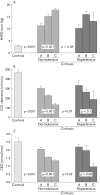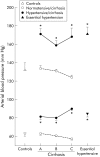Arterial hypertension in cirrhosis: arterial compliance, volume distribution, and central haemodynamics
- PMID: 16474108
- PMCID: PMC1856081
- DOI: 10.1136/gut.2005.064329
Arterial hypertension in cirrhosis: arterial compliance, volume distribution, and central haemodynamics
Abstract
Background and aims: Arterial hypertension is a common disorder. Hyperkinetic circulation and reduced effective volaemia are central elements in the haemodynamic dysfunction in cirrhosis. The aim of the present study was to investigate whether cirrhotic patients with arterial hypertension are normokinetic and normovolaemic or whether they reveal the same circulatory dysfunction as their normotensive counterparts.
Material and methods: Thirty three patients with arterial hypertension were identified among 648 patients with cirrhosis: 14 in Child class A, 12 in class B, and seven in class C. Controls were 130 normotensive cirrhotic patients, 19 controls with normal arterial blood pressure and without liver disease, and 16 patients with essential arterial hypertension. All groups underwent haemodynamic investigation with determination of cardiac output (CO), plasma volume (PV), central blood volume (CBV), hepatic venous pressure gradient (HVPG), hepatic blood flow (HBF), arterial compliance (AC), and systemic vascular resistance (SVR) in the supine position.
Results: Liver function, as evaluated by galactose elimination capacity, indocyanine green clearance, HBF, and Child score, was significantly better in hypertensive cirrhotics than in their normotensive counterparts (p<0.05-0.01) but portal pressure was similar (HVPG 13 v 15 mm Hg; NS). AC was significantly lower and normal in the arterial hypertensive cirrhotic group (1.07 v 1.39 mm Hg/ml; p<0.02) and SVR was significantly higher and normal (1475 v 1020 dynxs/cm5; p<0.01). Arterial hypertensive cirrhotic patients were hyperdynamic (CO 6.80 v 7.14 l/min; NS) and central hypovolaemic (CBV 19.8 v 20.6 ml/kg; NS), as were normotensive patients, but differences were found in relation to arterial blood pressure. Whereas arterial pressure was inversely correlated with CO, PV, and Child score in the normotensive group (p< 0.01), the same correlations were either direct or insignificant in arterial hypertensive cirrhotics.
Conclusion: Arterial hypertensive cirrhotic patients are hyperkinetic and central hypovolaemic, in common with their normotensive counterparts, but vasodilatation is reduced and regulation of arterial blood pressure may be less deranged.
Conflict of interest statement
Conflict of interest: None declared.
References
-
- Groszmann R. Vasodilatation and hyperdynamic circulatory state in chronic liver disease. In: Bosch J, Groszmann R, eds. Portal hypertension. Pathophysiology and treatment. Oxford: Blackwell, 199417–26.
-
- Møller S, Bendtsen F, Henriksen J H. Splanchnic and systemic hemodynamic derangement in decompensated cirrhosis. Can J Gastroenterol 20011594–106. - PubMed
Publication types
MeSH terms
LinkOut - more resources
Full Text Sources
Medical
Miscellaneous




